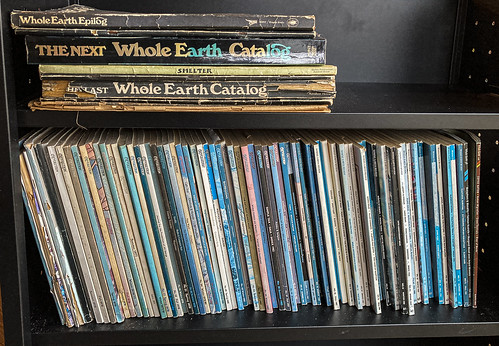Manual for Civilization
(working notes, begun 12iii22, under construction)
Once again email from John (11iii22) inspires a line of thought and exploration via a link to Brian Eno's list of 'books that could be used to rebuild civilization' which links to the Long Now Foundation's Manual for Civilization, "a collection of books humanity could use to rebuild civilization" that's an actual Library. See also the Rosetta Project ("a global collaboration of language specialists and native speakers working to build a publicly accessible digital library of human languages").
My first glance at Eno's list discloses several authors I revere (though generally not the specific books of theirs on my shelves), and a few others I've heard of but really haven't incorporated into my personal hagi-bibliography, and some I know nothing about. Of course an Amazon order was spawned, for the Cambridge World History of Food, used...
Eno's list got me thinking about the art of Collection Development, one of the the enthusiasms that has flourished from the days at Simmons, and that I fancy I've been practising ever since—or actually was practicing long before I knew that I was speaking prose, before I had a name for my addiction to books (and other Information media ==> musical, photographic, etc.).
And all of that plunks me back into Whole Earth mindspace, territory that is congenial, endless, fascinating, provocative (in the sense of being awash in tempting rabbit holes), and which I've never left, truth be told.
And to the realization that one of my very first connections into that world was via somebody I never met, but have known of since Chadwick days, and in some senses have dogged the footsteps of:

Jim Fadiman
Chadwick 1956 (the graduating class just before I arrived there, and classmate of Christina Crawford). Harvard 1960 (the year before I got there), where his advisor was Richard Alpert. Stanford PhD in Psychology 1965; he was Stewart Brand's LSD guide.
and so, while we're in the neighborhood, a quick step to the side to
Anne Fadiman (Jim's cousin, Harvard 1975), a marvelous writer:
The Spirit Catches You and You Fall Down: A Hmong Child, Her American Doctors, and the Collision of Two Cultures
Ex Libris: Confessions of a Common Reader
The Wine Lover's Daughter: A Memoir
At Large and At Small: Familiar Essays
...and to another very personally influential Fadiman book, Clifton (Anne's dad) this time: Fantasia Mathematica (to which I was introduced by Phil Coyle, who taught Plane and Solid Geometry to a small group of us, at Chadwick in 1958-59)
* * * * *
So Stewart Brand: another never-met-face-to-face, but a powerful influence for 50+ years. Eventually we'll get to
but along the way it's interesting to pass by my Whole Earth holdings, all books or book-like objects that influenced me mightily with each iteration. A partial list of holdings:
Whole Earth Catalog: Access to Tools: Fall 1969 (1969)
Whole Earth Catalog, Access to Tools, Fall 1970 (1970)
The Last Whole Earth Catalog: Access to Tools (1971)
Shelter Lloyd Kahn (1973)
The Updated Last Whole Earth Catalog: Access to Tools (1974)
II Cybernetic Frontiers Stewart Brand (1974)
Whole Earth Epilog (1974)
Whole Earth Software Catalog 1986 (1985)
The Essential Whole Earth Catalog J Baldwin (1986)
The Media Lab: Inventing the Future at M.I.T. Stewart Brand (1987)
Signal: The Whole Earth Catalog Kevin Kelly (1988)
The Millennium Whole Earth Catalog Howard Rhinegold (1994)
How Buildings Learn: What Happens After They're Built Stewart Brand (1995)
As I've noted elsewhere, CoEvolution Quarterly and its successor Whole Earth Review were vital resources in the 70s and 80s, the Acadia Years. Open one anywhere and be transported to another time and other possibilities.
(shown here with part of the Catalog archive)

I eagerly await the arrival of News that stayed news, 1974-1984: Ten years of CoEvolution Quarterly
* * * * *
Anyway, the point here was to consider what I might add to the Manual of Civilization, which is an opportunity/encitement to begin another pass at discovering the possible organizational schemes (in the mycelial sense) for the stuff in my library or is it libraries. And that means thinking about why the many and various volumes are where they are (in space, in time, in the mycelial map that I can imagine but not execute, in my memory), and that's always fun to work at.
I'm reminded of the project I did in 1991 to design a research collection for the editorial offices of the Society for the History of Technology (for a Simmons class on Science Librarianship taught by MIT's Head Librarian Jay Lucker), a massive overkill. I may get to scanning that and linking...
* * * * *
I'm not sure if this will turn out to have any utility, but an hour spent this morning on SUBJECT AREAS produced this [disorderly] list of library sub-parts, which will surely grow and mutate if I spend actual time on augmenting, sorting books, playing with shelving, etc.:
- History
- Technology
- Mind
- Visualization
- Nature/Ecology
- Landscape
- Language
- Epidemiology
- Geography
- Atlases
- Music
- Photography
- Information
- Biography
- Food
- Fiction
- Anthropology
- Nacirema
- Graphic/Comic
- Biblio
- Humor
- Anglophilia
- New England
- ...
And of course each needs a Finding Aid, tantamount to a map.
